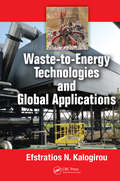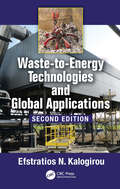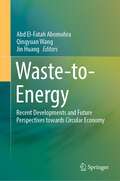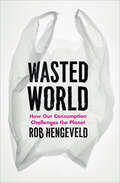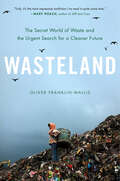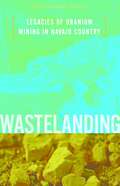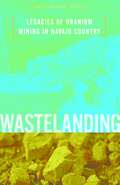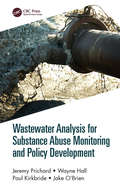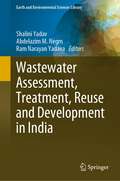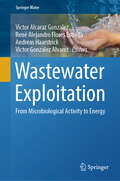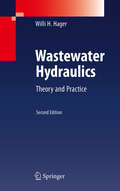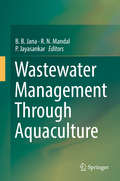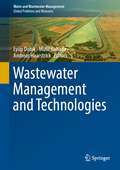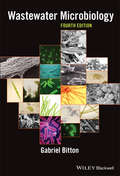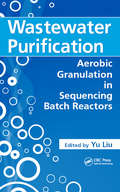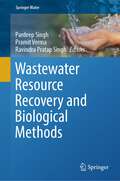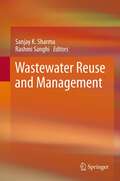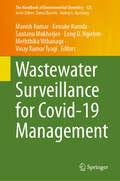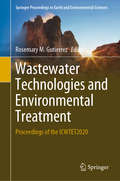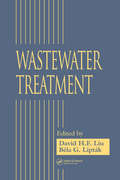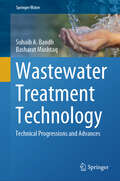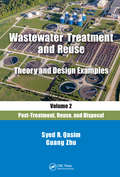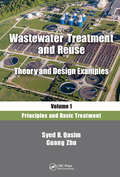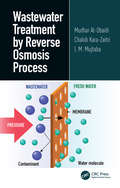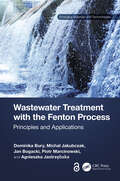- Table View
- List View
Waste-to-Energy Technologies and Global Applications
by Efstratios N. KalogirouThrough Waste-to-Energy (WtE) technology, plants use waste as a renewable fuel to co-produce electricity, heating, and cooling for urban utilization. This professional book presents the latest developments in WtE technologies and their global applications. The first part of the book covers thermal treatment technologies, including combustion, novel gasification, plasma gasification, and pyrolysis. It then examines 35 real-world WtE case studies from around the world, analyzing technical information behind planning, execution, goals, and national strategies. Results through the years show the benefits of the technology through the life cycle of the products. The book also examines financial and environmental aspects.
Waste-to-Energy Technologies and Global Applications
by Efstratios N. KalogirouThrough waste-to-energy (WtE) technology, relevant WtE plants use waste as a renewable fuel to co-produce electricity, heating, and cooling for urban utilization. Updated to reflect the latest developments in this field, the second edition of Waste-to-Energy Technologies and Global Applications also adds three new chapters covering waste to hydrogen, carbon capture and storage/utilization, and additional discussion on new WtE plants in Dubai and the Middle East. Covers thermal treatment technologies including combustion, novel gasification, plasma gasification, and pyrolysis Examines dozens of real-world WtE case studies from around the world, analyzing technical information behind planning, execution, goals, and national strategies Explains financial and environmental aspects Features new content on waste to hydrogen, carbon capture and storage/utilization, and new WtE plants in Dubai and the Middle East This book is aimed at professionals in environmental, chemical, energy, and related fields of engineering. It will also be of interest to policy-making governmental authorities, construction companies, and financial institutions.
Waste-to-Energy: Recent Developments and Future Perspectives towards Circular Economy
by Jin Huang Abd El-Fatah Abomohra Qingyuan WangThis book addresses the needs of students, researchers, as well as engineers and other professionals or readers interested in recent advances of biofuel and efficient waste management. In the context of energy consumption, over 85% of the total consumed energy comes from non-renewable fossil resources. Developing new renewable energy resources, especially biofuel production from wastes, has received increasing attention. The book is organized into three sections, namely Section I: Conventional waste management; Section II: From waste to green energy; and Section III: Case studies and future perspectives. Each section presents topic-specific chapters, which contain comprehensive and advanced knowledge of the subjects. Overall, the book covers the recent advances, breakthroughs, challenges, and future perspectives of waste-to-energy approach using different kinds of wastes as a feedstock for alternative biofuels and other integrated approaches such as wastewater treatment, plastic degradation, and CO2 sequestration in a cost-effective and eco-friendly way. In addition, different routes of waste recycling for enhanced biofuel production and case studies are presented with environmental and economic analysis. The presented case studies and future perspectives under Section III complement the chapters as they are authored by experts from bioenergy businesses who actually encounter real-world problems.
Wasted World: How Our Consumption Challenges the Planet
by Rob HengeveldThis biologist&’s &“monumental cri de Coeur&” for our planet offers a holistic view of our species, the waste we produce, and a path toward sustainability (Nature). In Wasted World, Rob Hengeveld traces the entwined histories of population growth and resource consumption to reveal how our global waste crises came about. As Hengeveld explains, human life depends on energy, which we first obtained through food. Later, we supplemented this with energy from water, wind, animals, and finally fossil fuels, as one source after another fell short of our ever-growing needs. Greater energy consumption has created greater waste, including the atmospheric waste that is driving climate change. As we face a web of interconnected problems, addressing them individually will not work. Instead, Hengeveld argues, we need to tackle their common cause: our staggering population growth. A practical look at the sustainability of our planet from a biologist and expert in the abundances and distributions of species, Wasted World examines the whole process of using, wasting, and exhausting energy and material resources. And by elucidating the complexity of the causes of our current global state, Hengeveld offers us a way forward.
Wasteland: The Secret World of Waste and the Urgent Search for a Cleaner Future
by Oliver Franklin-WallisNAMED A BEST BOOK OF THE YEAR 2023 BY THE NEW YORKER, THE GUARDIAN, and KIRKUS REVIEWS An award-winning investigative journalist takes a deep dive into the global waste crisis, exposing the hidden world that enables our modern economy—and finds out the dirty truth behind a simple question: what really happens to what we throw away? In Wasteland, journalist Oliver Franklin-Wallis takes us on a shocking journey inside the waste industry—the secretive multi-billion dollar world that underpins the modern economy, quietly profiting from what we leave behind. In India, he meets the waste-pickers on the front line of the plastic crisis. In the UK, he journeys down sewers to confront our oldest—and newest—waste crisis, and comes face-to-face with nuclear waste. In Ghana, he follows the after-life of our technology and explores the global export network that results in goodwill donations clogging African landfills. From an incinerator to an Oklahoma ghost-town, Franklin-Wallis travels in search of the people and companies that really handle waste—and on the way, meets the innovators and campaigners pushing for a cleaner and less wasteful future. With this mesmerizing, thought-provoking, and occasionally terrifying investigation, Oliver Franklin-Wallis tells a new story of humanity based on what we leave behind, and along the way, he shares a blueprint for building a healthier, more sustainable world—before we&’re all buried in trash.
Wastelanding: Legacies of Uranium Mining in Navajo Country
by Traci Brynne VoylesWastelanding tells the history of the uranium industry on Navajo land in the U. S. Southwest, asking why certain landscapes and the peoples who inhabit them come to be targeted for disproportionate exposure to environmental harm.
Wastelanding: Legacies of Uranium Mining in Navajo Country
by Traci Brynne VoylesWastelanding tells the history of the uranium industry on Navajo land in the U.S. Southwest, asking why certain landscapes and the peoples who inhabit them come to be targeted for disproportionate exposure to environmental harm. Uranium mines and mills on the Navajo Nation land have long supplied U.S. nuclear weapons and energy programs. By 1942, mines on the reservation were the main source of uranium for the top-secret Manhattan Project. Today, the Navajo Nation is home to more than a thousand abandoned uranium sites. Radiation-related diseases are endemic, claiming the health and lives of former miners and nonminers alike. Traci Brynne Voyles argues that the presence of uranium mining on Diné (Navajo) land constitutes a clear case of environmental racism. Looking at discursive constructions of landscapes, she explores how environmental racism develops over time. For Voyles, the &“wasteland,&” where toxic materials are excavated, exploited, and dumped, is both a racial and a spatial signifier that renders an environment and the bodies that inhabit it pollutable. Because environmental inequality is inherent in the way industrialism operates, the wasteland is the &“other&” through which modern industrialism is established. In examining the history of wastelanding in Navajo country, Voyles provides &“an environmental justice history&” of uranium mining, revealing how just as &“civilization&” has been defined on and through &“savagery,&” environmental privilege is produced by portraying other landscapes as marginal, worthless, and pollutable.
Wastewater Analysis for Substance Abuse Monitoring and Policy Development
by Wayne Hall Jeremy Prichard Paul Kirkbride Jake O'BrienThis book addresses how to estimate substance use and thereby evaluate policies intended to reduce the harms caused by drugs and other substances. Wastewater analysis (WWA) can provide efficient, affordable, fine-grained and objective data on population substance use trends on a very large scale. The authors discuss the potential implications of WWA as a new method for understanding substance use in a variety of settings and ignite a discourse with policy makers, criminologists, epidemiologists and other disciplines about the need for collaboration with WWA scientists. The book also features an explanation of the costs and harms of substance use with academic literature from criminological and epidemiological sources and reports from lead agencies. Additional features include: Details on the origin of wastewater analysis in environmental science Description of analytical chemistry methods for tracing a wide variety of substances, including illicit drugs, alcohol, tobacco and other chemicals Exploration of the major empirical problems in estimating population consumption of alcohol, tobacco and drugs at the international and national level Examination of the principles of human research ethics and their application to wastewater analysis Wastewater Analysis for Substance Abuse Monitoring and Policy Development is a valuable tool for analytical chemists, wastewater scientists and criminologists, as well as researchers and policy makers across disciplines who work in drug sectors.
Wastewater Assessment, Treatment, Reuse and Development in India (Earth and Environmental Sciences Library)
by Abdelazim M. Negm Shalini Yadav Ram Narayan YadavaThis book contains up-to-date information and findings in research on the evaluation, treatment, reusability, and development of wastewater in India. The book covers the assessment for drinking water, including membrane filtration, supervision, and evaluation of wastewater, environmental pollution control, wastewater treatment and recycling, advanced bioremediation techniques and wastewater's impact on India. With this wide range of treatment and technologies of wastewater, this book is a source of invaluable information to guide Indian policy planners and makers to move forward to achieve the Sustainable Development Goal 6.
Wastewater Exploitation: From Microbiological Activity to Energy (Springer Water)
by Andreas Haarstrick Victor Alcaraz Gonzalez René Alejandro Flores Estrella Victor Gonzalez AlvarezWith all the current efforts to use non-fossil sources as a starting point for future energy solutions, consideration is also being given to using microbial activities as a direct or indirect source of energy production. This ranges from the use of algae as biomass or as H2 producers, anaerobic microorganisms to produce methane, hydrogen, and even electricity directly. This book deals with both theoretical and technical possibilities of using anaerobic microorganisms in combination with wastewater as a substrate source to produce biofuels and bioenergy in the form of biomass, CH4 and H2 as well as the corresponding power densities and electricity quantities in economically justifiable processes. Unique process facilities are widely addressed; however, special interest is also placed in biorefinery and circular economy related concepts. The theoretical background as well as application examples are presented.
Wastewater Hydraulics
by Willi H. HagerThe second, enlarged edition of this established reference integrates many new insights into wastewater hydraulics. This work serves as a reference for researchers but also is a basis for practicing engineers. It can be used as a text book for graduate students, although it has the characteristics of a reference book. It addresses mainly the sewer hydraulician but also general hydraulic engineers who have to tackle many a problem in daily life, and who will not always find an appropriate solution. Each chapter is introduced with a summary to outline the contents. To illustrate application of the theory, examples are presented to explain the computational procedures. Further, to relate present knowledge to the history of hydraulics, some key dates on noteworthy hydraulicians are quoted. A historical note on the development of wastewater hydraulics is also added. References are given at the end of each chapter, and they are often helpful starting points for further reading. Each notation is defined when introduced, and listed alphabetically at the end of each chapter. This new edition includes in particular sideweirs with throttling pipes, drop shafts with an account on the two-phase flow features, as well as conduit choking due to direct or undular hydraulic jumps.
Wastewater Management Through Aquaculture
by B. B. Jana R. N. Mandal P. JayasankarThis volume provides state-of-the-art information on soil-water interactions in wastewater systems, characterization of wastewater, modes of treatment, safety of wastewater use, water conservation technologies involved in recycling of sewage in fish culture, biogeochemical cycling bacteria and nutrient dynamics, ecosystem resilient driven wastewater reclamation, bioremediation, aquaponics, ecological integrity, culture practices of fish farming, microbial food web phenomena, fish diseases, environmental economics of wastewater, environmental risk assessment, environmental law and regulations. Given its breadth of coverage, the book will be useful to researchers, teachers, students, administrators, planners, farmers and entrepreneurs interested in the profitable use of wastewater in the wastes-into-wealth framework of for the benefit of humanity, and in achieving the targets for sanitation and safe wastewater reuse by 2030, specified in the United Nations’ Sustainable Development Goals.Concerns are growing about the quality and quantity of fresh water, as severe crises are expected in the near future. Climate change has further worsened the strain on inland water resources, with its major impacts on ecosystems and human life. It is most urgent to protect and conserve inland water resources to maintain vital ecosystem functions. Despite the immense nutrient potentials of wastewater in terms of phosphorus, nitrogen and potassium and increasingly high rates of urbanization-based wastewater generation, wastewater has traditionally been overlooked as a resource. This produces a threefold loss – environmental degradation, monetary losses from fertilizers, and water. As a result, municipal wastewater offers a win-win strategy for water conservation and environmental protection, while also turning waste into wealth in the form of fish biomass and allied cash crops. Wastewater-fed aquaculture refers to a unique, integrated biosystem in which the wastes generated by the first system are used by the next subsystem. In wastewater-fed aquaculture biosystems, the organic wastes are recycled into fish biomass mediated through a complex microbial/autotrophic/heterotrophic food web mechanism.
Wastewater Management and Technologies (Water and Wastewater Management)
by Müfit Bahadir Andreas Haarstrick Eyüp DebikThis book edition on "Wastewater Management and Technologies" brings together a wealth of expertise by the authors, who exemplify the wide range of options available—from nature-based solutions to different levels of technology—and the different experiences through case studies from around the world, with a particular focus on conditions in developing countries. The book is part of a book series (special editions) based on the publication of the book "Water and Wastewater Management", published by Springer in 2022 (ISBN 978-3-030-9528-7). The part about "Wastewater Management and Technologies" edited in this book will be deepened with this first special edition in terms of technological topics.
Wastewater Microbiology
by Gabriel BittonWastewater Microbiology focuses on microbial contaminants found in wastewater, methods of detection for these contaminants, and methods of cleansing water of microbial contamination. This classic reference has now been updated to focus more exclusively on issues particular to wastewater, with new information on fecal contamination and new molecular methods. The book features new methods to determine cell viability/activity in environmental samples; a new section on bacterial spores as indicators; new information covering disinfection byproducts, UV disinfection, and photoreactivation; and much more. A PowerPoint of figures from the book is available at ftp://ftp.wiley.com/public/sci_tech_med/wastewater_microbiology.
Wastewater Purification: Aerobic Granulation in Sequencing Batch Reactors
by Yu LiuA newcomer to the scene, aerobic granulation is on its way to becoming the hot new technology for high-efficiency wastewater treatment. Thus far, intensive research has been conducted with regard to the understanding of the mechanism of aerobic granulation in sequencing batch reactors (SBR) and its application in treating a wide variety of municipa
Wastewater Resource Recovery and Biological Methods (Springer Water)
by Pardeep Singh Pramit Verma Ravindra Pratap SinghThe book is unique in highlighting the issue of wastewater as one of the important environmental issues. The uniqueness also lies in exploring the concepts of converting waste into resources in the form of bioenergy, biofertilizers through various biological methods. Given the international scenario, the chapters of this book are designed to include both anaerobic and aerobic methods of resource recovery from the industrial wastewater. The book is a step toward design with nature and the concept of green chemistry.Waste menace is one of the most voiced and unsolved problems in the entire world. The whole world is facing the threat of water pollution, soil pollution/ land pollution, odour pollution from the growing waste. Though we find many missions and programs at international, national, and regional level to solve the waste associated issues, this is mostly in context with the solid fraction of the waste. Very little is being done to manage the liquid part of the waste or what we call the wastewater.The conversion of wastewater has the potential to be converted to energy in the form bioenergy, bio-fertilizers, electricity, nutrient recovery, etc. The use of sludge as biofertilizers solves the problem of sludge management on the one hand and production of organic crops on the other. The biological treatment methods like sludge treatment gives the farmers the source of biofertilizers and organic manure for the plants. In the present scenario, energy crisis is also one of the issues that we are facing particularly in context with the thermal power plants which are environmentally highly polluting. Through various techniques like microbial fuel cells or biohydrogen, we get a source of cleaner energy. So, through this book, we try to produce the content and information to give the audience an understanding of the waste water as one of the environmental and health issues and mitigation strategies. The book gives a sufficient understanding of how waste can be turned into a resource.
Wastewater Reuse and Management
by Rashmi Sanghi Sanjay K. SharmaOver the past 50 years the volume of wastewater has grown exponentially as a result of the increasing world population and the expansion of industrial developments. Researchers all over the world have been trying to address this issue suitably in order to fight water scarcity; yet, it is only recently that wastewater recycling has caught their attention as an effective and responsible solution. Wastewater is a resource that can be adequately treated to successfully satisfy most water demands as well as decreasing wastewater discharges and preventing pollution. This book presents the studies of some of the most prestigious international scientists and gathers them in three different sections: Wastewater Management and Reuse, Wastewater Treatment options and Risk Assessment. The result is an insightful analysis of waste water management, its treatments, and the processes that have been studied, optimized and developed so far to sustain our environment. Wastewater Reuse and Management represents a valuable resource to academic researchers, students, institutions, environmentalists, and anyone interested in environmental policies aimed at safeguarding both the quality and the quantity of water.
Wastewater Surveillance for Covid-19 Management (The Handbook of Environmental Chemistry #125)
by Manish Kumar Vinay Kumar Tyagi Santanu Mukherjee Meththika Vithanage Keisuke Kuroda Long D. NgiehmThis book reviews the recent challenges and future perspectives involved in the wastewater-based epidemiology (WBE) for COVID-19. The book aims to improve the monitoring of COVID-19 in wastewater by focusing on recent scientific studies in the surveillance and treatment of wastewater containing SARS-CoV-RNA, assessment of COVID-19 in the community and delivering a new scientific understanding of prevalence and re-emergence based on the WBE. It also provides a global perspective on effective detection methods for the analysis and interpretation of the RNA count of SARS-CoV-2 virus in wastewater and predicts the effects wastewater may have on the infection rate.Readers will find in this book case studies from France, India and Southeast Asian of non-invasive population-based monitoring of SARS-CoV-2 through sewage surveillance, and will learn more about the virus behaviour and transmission in different environmental settings. The significance of membrane technologies for virusremoval from water is also addressed in this book, as well as advanced techniques for identifying, quantifying, and characterizing SARS-CoV-2 in activated sludge and wastewater. The book provides a great interface to researchers such as microbiologists, environmental engineers, data scientists and civil engineers, emphasizing issues related to the current monitoring methodology. Furthermore, it also encourages researchers and policymakers by raising awareness of potential new methodologies for wastewater surveillance and accurate monitoring of COVID-19.
Wastewater Technologies and Environmental Treatment: Proceedings of the ICWTET2020 (Springer Proceedings in Earth and Environmental Sciences)
by Rosemary M. GutierrezThis proceedings book provides the latest developments on water as a unique resource that can meet the fundamental needs of human beings and ecosystems. Wastewater generated in industrial, commercial, residential and sensible places must take care as it may pollute the ground and surface water if not treated properly. Environmental pollution discharged from industrial, commercial, residential and sensible places must take care as it may pollute the air, water and land if not treated properly. Most of the design and development of wastewater technologies and environmental treatment were unable to take load as there is huge amount of wastewater and environmental pollution that was generating every day. This threatens the sustainable development, and it needs to solve in accurate, reliable, urgent and timely. Our interest is sustainable innovative and technological transfer approaches which can be used available for supporting, operationalizing and delivering sustainable wastewater technologies and environmental treatment. The authors hope that the book covers possible spectrum of wastewater technologies and environmental treatment to high level of environmental protection, clean and green management lessons, identifies the barriers for transformative change and then informs agenda and initiatives for the sustainable development. ICWTET2020 is dedicated to wastewater technologies and environmental treatment, with a focus on the high level of environmental protection. The aim of the ICWTET2020 is to disseminate current knowledge and sustainable development, share experience and lessons learned and stimulate discussion and reflection, thus promoting a sustainable paradigm shift. The final purpose is to contribute transformative change towards sustainable development through dissemination of sustainable wastewater technologies and environmental treatment.
Wastewater Treatment
by David H.F. Liu Paul A. BoutsIn an exhaustive compilation of current knowledge, Wastewater Treatment covers subjects that run the gamut from wastewater sources, characteristics, and monitoring to chemical treatments and nutrient removal. Thoroughly examining basic and advanced topics, this resource has it all. The wealth of easy-to-use tables and illustrations provides quick and clear references, making it indispensable. Schematic drawings of equipment and devices explain the technology and techniques. With the level of detail included, you can count on finding both introductory material and very technical answers to complex questions.It's seamless style clearly delineates what can and must be done to continue to improve the quality of our water. Wastewater Treatment is a valuable resource; appropriate for engineers and students but readable enough for anyone interested in the discipline.Béla G. Lipták speaks on Post-Oil Energy Technology on the AT&T Tech Channel.
Wastewater Treatment Technology: Technical Progressions and Advances (Springer Water)
by Basharat Mushtaq Suhaib A. BandhAs global populations surge, the availability of clean water continues to decline, necessitating a paradigm shift toward pollution mitigation and sustainable water management. The indiscriminate disposal of untreated wastewater is no longer a viable option, underscoring the critical need for advanced treatment technologies. Wastewater Treatment Technology provides a comprehensive introduction to the core principles of wastewater treatment, coupled with the engineering design of unit processes essential for the sustainable management of municipal wastewater. The book systematically explores key aspects, including wastewater treatment methodologies, drinking water purification, water quality standards, sludge management, and treatment plant design. Each concept is presented with a strong theoretical foundation, ensuring clarity and coherence in technical applications. Additionally, the text integrates recent advancements in wastewater treatment technologies, reflecting the evolving landscape of the field.Developed from a course taught by the authors over several years, this book is tailored for undergraduate and postgraduate students with a background in environmental science, water resource management, and environmental engineering. It offers a robust grounding in fundamental principles while equipping readers with the expertise to design and optimize unit processes in municipal wastewater treatment systems. Industry professionals will also find it an invaluable reference for practical applications. Beyond academia, this book serves as a crucial resource for researchers and policymakers engaged in wastewater management. It provides scientific methodologies and analytical frameworks necessary for developing viable and sustainable strategies aligned with global environmental goals. Addressing a critical gap in wastewater treatment literature, this text offers a well-structured and comprehensive compilation essential for students, researchers, and decision-makers striving to achieve the UN Sustainable Development Goals (SDGs) through innovative and efficient wastewater solutions.
Wastewater Treatment and Reuse Theory and Design Examples, Volume 2: Post-Treatment, Reuse, and Disposal
by Guang Zhu Syed R. QasimThis book will present the theory involved in wastewater treatment processes, define the important design parameters involved, and provide typical values of these parameters for ready reference; and also provide numerical applications and step-by-step calculation procedures in solved examples. These examples and solutions will help enhance the readers’ comprehension and deeper understanding of the basic concepts, and can be applied by plant designers to design various components of the treatment facilities. It will also examine the actual calculation steps in numerical examples, focusing on practical application of theory and principles into process and water treatment facility design.
Wastewater Treatment and Reuse, Theory and Design Examples, Volume 1: Principles and Basic Treatment
by Guang Zhu Syed R. QasimThis book will present the theory involved in wastewater treatment processes, define the important design parameters involved, and provide typical values of these parameters for ready reference; and also provide numerical applications and step-by-step calculation procedures in solved examples. These examples and solutions will help enhance the readers’ comprehension and deeper understanding of the basic concepts, and can be applied by plant designers to design various components of the treatment facilities. It will also examine the actual calculation steps in numerical examples, focusing on practical application of theory and principles into process and water treatment facility design.
Wastewater Treatment by Reverse Osmosis Process: State of the Art & Process Modelling (Wastewater Treatment by Reverse Osmosis, Two-Volume Set)
by Mudhar Al-Obaidi Chakib Kara-Zaitri I. M. MujtabaWastewater Treatment by Reverse Osmosis Process provides a one-stop-shop for reverse osmosis (RO), outlining its scope and limitations for the removal of organic compounds from wastewater. This book covers the state-of-the-art on RO processes and describes ten RO process models of different features and complexities. It also covers the advanced model-based techniques for RO process operations, including various rigorous methods for process modelling, simulation, and optimization at the lowest energy cost, as well as advanced tools such as genetic algorithms for achieving the same. • Highlights different types of physico–chemical and biological wastewater treatment methods including hybrid systems• Provides an overview of membrane processes, focuses on different types of membrane processes for water treatment and explains characteristics of membrane modules• Introduces the importance and challenges of process modelling for simulation, design, and optimization and offers examples across various industries •Describes the concept of different types of genetic algorithms for process optimisation and provides the state-of-the art of the GA method in terms of its application in water desalination and wastewater treatment •Emphasizes economic aspects of RO processes for wastewater treatment With its focus on the challenges posed by an increasing demand for fresh water and the urgent need to recycle wastewater at minimum cost, this work is an invaluable resource for engineers and scientists working within the field of wastewater treatment.
Wastewater Treatment with the Fenton Process: Principles and Applications (Emerging Materials and Technologies)
by Agnieszka Jastrzębska Dominika Bury Michał Jakubczak Jan Bogacki Piotr MarcinowskiThe presence of refractory organic compounds in wastewater is a global problem. Advanced oxidation processes, in general, and the Fenton oxidation process are alternative technologies for wastewater and water treatment. This book gives an overview of Fenton process principles, explains the main factors influencing this technology, includes applications, kinetic and thermodynamic calculations and presents a strong overview on the heterogeneous catalytic approach. It demonstrates that the iron-based heterogeneous Fenton process, including nanoparticles, a new complex solution, is highly efficient, environmentally friendly and can be suitable for wastewater treatment and industrial wastewater. FEATURES Describes in detail the heterogeneous Fenton process and process applications Analyzes the advantages and disadvantages of different catalysts available and their suitability to specific processes Provides economic analysis of the Fenton process in a ready-to-use package for industrial practitioners for adaptation into already existing industrially viable technologies Promotes a modern solution to the problem of degradation of hazardous compounds through ecological and environmentally friendly processes and the use of a catalyst that can be recycled Explains highly complex data in an understandable and reader-friendly way Intended for professionals, researchers, upper-level undergraduate and graduate students in environmental engineering, materials science, chemistry, and those who work in wastewater management.
